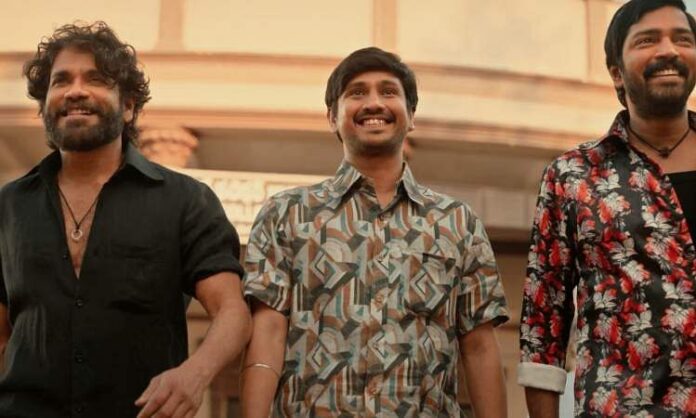It is one thing to release films at festivals. Another thing is to have films so massive in scale and hype, that their release becomes a festival unto itself. In a third, not-so-common category, exist films that are released on the day of the festival and we see them celebrating said festival within the film. This is not an easily won coincidence. Farah Khan’s Happy New Year (2014) came out in Diwali that year. Sriram Raghavan’s latest trilingual outing Merry Christmas, came out in Sankranti this year. While Sankranti (2005), a family drama, starring Venkatesh, Srikanth and Sneha, came out in February, Dasara (2023) was released in late March. Naa Saami Ranga, a film made with the express purpose of releasing it in theatres for Sankranti, was structured to release around the festival itself. The film was shot at a breakneck pace, in a piece of three months. It helped that Naa Saami Ranga’s story isn’t original, adapting it from Joshiy’s film Porinju Mariam Jose (2019). Naa Saami Ranga sticks to the skeletal structure of its predecessor while firmly rooting it around the three-day harvest festival in a coastal Andhra village.
Director – Vijay Binni
Cast – Nagarjuna Akkineni, Allari Naresh, Raj Tarun, Ashika Ranganath, Mirnaa, Rukhsar Dhillon, Shabeer Kallarakkal, Nasser
Set in 1988, Naa Saami Ranga borrows its title from an oft-repeated phrase used by the film’s protagonist Kishtayya (Nagarjuna Akkineni) in the film. Kishtayya is an orphan, who is taken in by strangers Anji (Allari Naresh) and his mom. After his mom’s demise, the brothers grow up on their own. When a wily money lender (Rao Ramesh) tries to usurp their house after their mother’s death, they are saved by Peddhayya (Nasser). Through the characters played by Rao Ramesh and Nasser, we see the class divide in their village Ambajipeta. When Peddhayya begins to treat Anji and Kishtayya as his own, he earns resentment and scorn from his sons, emotions that sow the roots for the enmity that festers much later in the film. Though we see two sons at first, we eventually find out that there is a third spawn more malevolent than the rest. Sarpatta Parambarai-fame actor ‘Dancing Rose’ Shabeer Kallarakkal, who is absent in the film’s initial portions, makes his presence as a principal antagonist in the latter parts of Naa Saami Ranga. Shabeer joins Fahadh Faasil (Pushpa) and Shine Tom Chacko (Dasara, Rangabali) in the list of Malayali actors crafting a niche for themselves as Telugu cinema villains. A slow but steady trend, rising in parallel to the oft-repeated, crowd-favourite trend of hiring North Indian, Mumbai-based actors to play villains in Telugu cinema.
Since Naa Saami Ranga is a Malayalam film remake, the assumption that this film is going to have a tight script proves untrue. If anything, Naa Saami Ranga feels like a collection of sequences. But more on that later. A large part of the film plays in flashbacks, narrated by Anji to Bhaskar (Raj Tarun). The flashbacks delve into how Kishtayya and his childhood sweetheart Varalakshmi alias Varalu reunite as adults. Their love story comes with a tragic end. Bhaskar and Anji have partners too. While the former is in love with the president’s daughter from another town, which causes strife between the towns, Allari Naresh’s Anji reunites with his Ugram co-star Mirnaa.
For the large part, Naa Saami Ranga is packaged well. With ample songs, fight sequences and emotional drama, the film could have certainly benefited from comedy, especially the old-school comedy tracks, performed by ensemble comedians, instead of just the lead actors. Naa Saami Ranga isn’t extremely ambitious, happily relying on an older form of storytelling. However, what sets it apart from films from the past is the extensive use of green screens and other virtual production hacks. Films made in the past did not have the luxury filmmakers now have. One could argue that films looked richer and more dynamic when shot on location and on film. This difference comes through starkly when people shoot period films nowadays, like Naa Saami Ranga. With this period film shot digitally, against green screens, it looks amateurish and dull. It is ironic that the film itself was released on Bhogi, a festival where old items are discarded by throwing them into the fire. As a film hastily packaged for Sankranti, by Sankranti and of Sankranti, it is hard to imagine Naa Saami Ranga having any shelf life beyond this Sankranti.
#passable #oldschool #festivalbait #entertainer #Cinema #express

